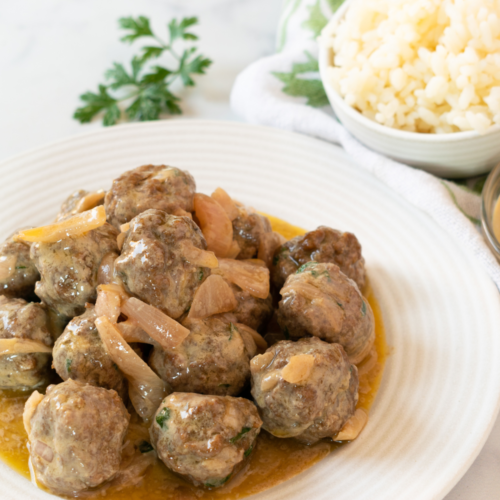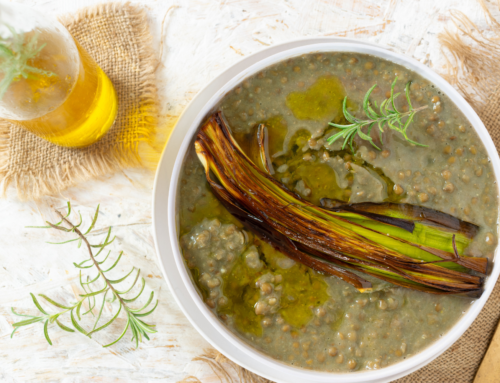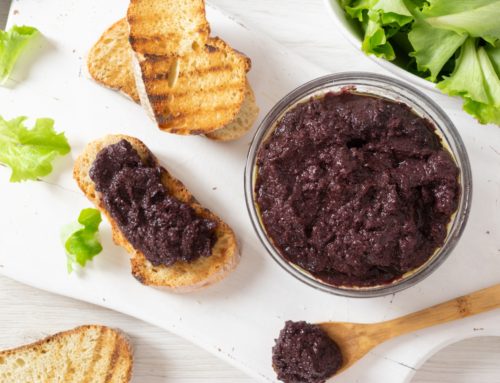Let us talk about beef kafta! Most Lebanese people love it and totally agree it tastes delicious. Over the centuries they’ve certainly mastered various ways of preparing it as well. You can find kafta grilled and fried and you can also find kafta served with vegetables, tomato sauce, and rice.
People also get creative with their shapes nowadays. Some form kafta into an oblong shape to put on skewers and cook on a charcoal grill to make beef kafta kabobs. Others shape the meat mixture into the form of small meatballs, as in this Lebanese kafta recipe. No matter how you shape it, the perfectly spiced kafta meat is enjoyed alongside many dishes, such as rice pilaf and fattoush.

Kafta, also spelled kofta depending on where you live, is a Persian word that means “powder.” This dish was so named based on the minced meat and kafta spices that are crushed and mixed together. Kafta is grilled or fried until the pieces of meat become soft and melt in the mouth. Kafta with tahini is a perfect combination. You experience the amazing taste of kafta melding with the tahini sauce.
Notes
- If you can’t get access to 7-spice, use this combination instead: two teaspoons of allspice, half a teaspoon of ground cumin, half a teaspoon of ground cinnamon, and half a teaspoon of coriander. If you want to add a little kick, go ahead and add an eighth of a teaspoon of cayenne pepper or crushed red pepper flakes.
- If you like, substitute the yellow onion in the meat mixture for sweet onion or green onions.
- I recommend using a food processor to finely chop the fresh parsley and onion before adding them to the kafta mixture. It makes a big difference.
FAQs
What is beef kafta made of?
Lebanese-style beef kafta is simply made from four ingredients: ground beef, onion, parsley, and Middle Eastern spices that have a similar cumulative taste to allspice.
What’s the difference between shish and kafta?
Shish is cubes of meat, while kafta is minced meat combined with other ingredients that are shaped into patties.
Can you make kafta with other types of minced meat?
Absolutely! Ground lamb kafta is always a popular option and you can even combine ground beef and ground lamb for a deliciously rich flavor. Other options include ground turkey, ground pork, and ground chicken.
Is beef kafta gluten-free?
Yes, this beef kafta recipe is gluten-free. All you have to do is serve it alongside your favorite gluten-free sides, such as rice and a side salad.
How do you store beef kafta?
You can store leftover beef kafta in an airtight container in the fridge for up to four days. Simply reheat in the microwave, oven, or air fryer. You can also freeze leftovers for up to three months. Thaw overnight in the fridge before reheating as instructed.
How do you serve beef kafta?
When I say there are endless ways to serve this Lebanese kofta recipe, I mean it. So here are just a few serving suggestions:
- Serve it on a bed of basmati rice, cauliflower rice, or rice pilaf with a side of toasted pita bread or Lebanese flatbread.
- Add a side salad like tabbouleh, fattoush, or couscous salad.
- Make your own side salad with lettuce, tomato, and cucumber.
- Add a side of grilled or roasted vegetables instead.
- Enjoy your beef kafta with tahini in a wrap along with your favorite salad ingredients.
Serve it with hummus, baba ganoush, or tzatziki instead of tahini.

Kafta with Tahini
Ingredients
For the Meatballs
- 1 pound lean ground beef
- 1 small yellow onion, peeled and minced
- ¼ cup chopped fresh parsley
- 1 tbsp Lebanese 7-spice seasoning
- 1 tsp salt
For the Tahini Sauce
- 4 tbsp tahini
- ¼ cup water
For the Kafta
- 2 small onions, peeled and cut into strips
- 3 tbsp extra virgin olive oil, divided
- ¼ tsp salt
Instructions
- For the meatballs: in a large bowl, use your hands to mix together the meat, onions, parsley, spices, and salt. Shape the meat with your hands into 1-inch meatballs then set them aside.
- For the tahini sauce: in a small bowl, mix the tahini and water until they are well combined, and then set aside the sauce.
- For the kafta: in a cooking pot, heat 2 tablespoons of the olive oil over medium heat, then stir in the onion strips and salt. Cook the onions for 3 to 4 minutes, until the onions become tender. Add the remaining 1 tablespoon of olive oil to the pan, then stir the meatballs and onions together. Cook, stirring occasionally, for 12 to 15 minutes, until the meatballs reach a temperature of 165 degrees F on an instant-read thermometer inserted into the center of a meatball.
- Stir the tahini into the mixture to coat the meatballs and onions. When the sauce comes to a boil, remove the pan from the heat and serve the kafta.





